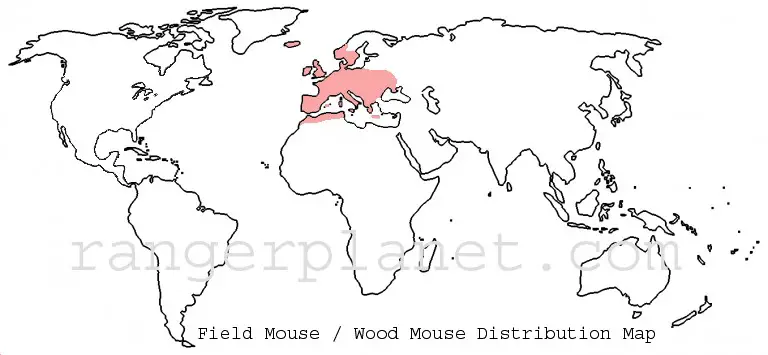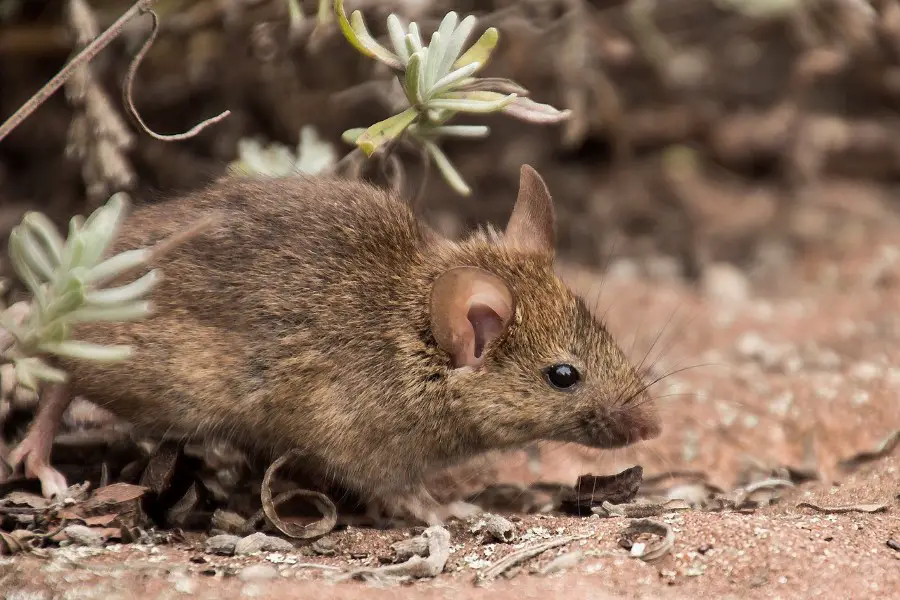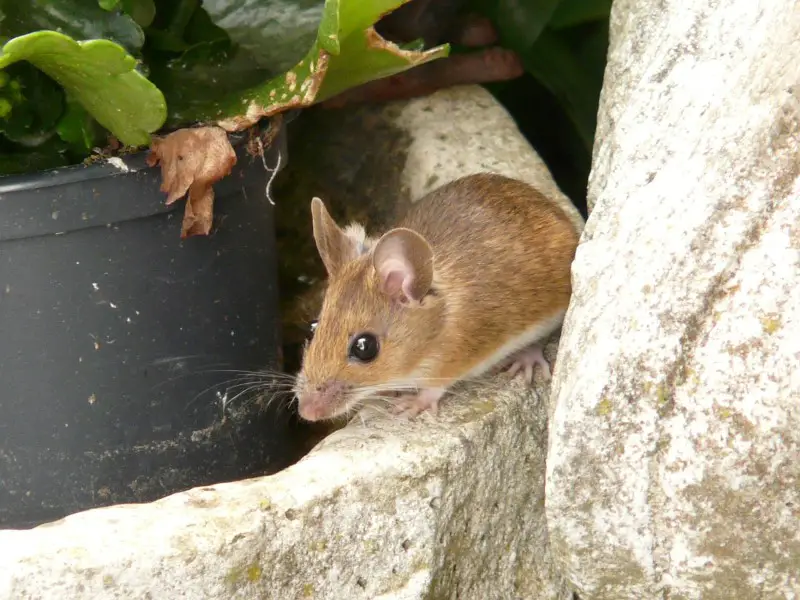Here we’re going to discuss the Field Mouse, also called Wood Mouse, their appearance, what they eat, what eats them! Their habitat, what parts of the world they live in. Their scientific classification, Wood mouse breeding and nesting habits, conservation and much more! What more could you possibly need?!
The names Field mouse and Wood mouse are often used interchangeably – so really you can use either and mean the same species.
Anyway, we thought we’d give their profile a bit of a lift, and here it is. But first, let’s just make sure we all know what a Field Mouse – or Wood Mouse is?
What Is A Field Mouse? The field mouse, is actually a Wood mouse, scientific name Apodemus sylvaticus. A mammal – native to Europe and northwestern Africa. It lives mostly in fields and woods and so is known as Field mouse or Wood mouse. Field mice are nocturnal omnivores and are considered an agricultural pest.
These cute creatures are often lost among the other great mice that people learn about and have as pets, but the humble little Field Mouse just keeps going, and sometimes it can be a bit of a nuisance!
With that overview set up, let’s get into more details about this long-tailed mouse.
Classification
Kingdom: Animalia
Phylum: Chordata
Class: Mammalia
Order: Rodentia
Family: Muridae
Genus: Apodemus
Species: A. sylvaticus Wood Mouse (Field Mouse)
Alternative names:
- Long-tailed field mouse
- Field mouse
- Common field mouse
- European wood mouse
Field mouse history
As we mentioned, field mouse is native to Europe and northwestern Africa and so it is mainly found throughout Europe (except for northern Scandinavia and Finland), northwestern Africa and southwestern Asia to the Altai and Himalayan mountains.
Its distribution extends to offshore islands around Britain, but it does not extend far into the coniferous zone. The field mouse is highly adaptable and so they are found in pretty much many habitats if it is not too wet or greatly exposed to the ground.
Field mouse geographical coverage
The field mouse has its geographical presence in continents such as Africa, Asia and Europe and subcontinents such as North Africa and Western Asia. More specifically field mouse is found in countries such as Albania, Algeria, Andorra, Austria, Belarus, Belgium, Bosnia and Herzegovina, Bulgaria, Croatia, and the Czech Republic.

Field mouse conservation status
Field mice are not protected by any conservation acts or frameworks. A field mouse is considered to be an abundant and highly adaptable species. There is an approximate number estimated at around ten million Wood mice in Ireland alone.
Given how widespread and distributed field mouse are, its population is estimated to be stable and strong in many parts of the world.
However, in recent times, the new arrival of the bank vole and greater white-toothed shrew are showing some evidence of a detrimental impact on the Field mouse. This is starting to show a significant reduction in the Field mouse numbers.
Field mouse color and appearance
The field mouse is bicolored with a yellowish-brown fur covering its top and pale white to grey fur on the underside/underbelly. It also has a yellowish patch of fur between its front legs.
The field mouse has large eyes and ears, long hind feet with a long and dark slender tail. The distinguishing long tail gives rise to its other common names ‘long-tailed field mouse’.
Field mouse size
The size of a field mouse is usually as long as the head. The body in length from nose-tip to anus on average measures between 8 to 11 cm (81-103mm). The tail is usually as long as the head and the body which on average measures between 7 to 9.5 cm (71-95 mm).
Field mouse weight
Field mouse on average weighs between 13 to 27g. In some cases like winter, the field mouse increase in weight between 17–27g as adults. This is a way of increasing body temperature for warmth. When it comes to weight the males are heavier than females.

Field mouse lifespan
The lifespan of a field mouse is on average limited to 20 months or often from one summer to the next summer. Like most of the mouse types, the main cause of mortality in field mouse is cold weather.
What Field mice eat
The field mouse is an omnivore but it’s more like an opportunist feeder. This is because a field mouse decides what it should eat depending on the time/season of the year, habitat, age and even the sex of individuals.
Dietary changes are more often than not a result of changing seasons and availability of food, including which foods are able to be stored.
| Field mouse diet | |
| Summer | Winter |
| Seeds | Seeds |
| Plants | Plants |
| Tree bark | Tree bark |
| Berries | Berries |
| Buds | Buds |
| Fruit | Fruit |
| Crops | Crops |
| Insects | |
| Fungi | |
| Moss | |
| Even Small Frogs! |
Likewise, depending on age, juveniles eat fewer seeds when compared to adults. And females are more towards being an herbivore because they eat less animal food compared to males during summer.
The overall diet and the foraging behavior of field mouse make it a good disperser of seeds which aids regeneration of vegetation.
Field mouse habitat
The specialty of a field mouse is that it’s highly adaptable and so can pretty much live anywhere as long as it’s not overly wet or overly arid. Although there are species of mice adapted to arid areas.
It’s scarce in urban areas and prefers grounds that are rich in ground cover. A field mouse is primarily a woodland species but they also thrive in arable land areas, ungrazed grassland, wetlands, hedgerows, field margins, as well as gardens and buildings.
It also lives in underground burrows (mostly in the winter) and even in abandoned bird nests that are located in trees that give them a secluded shelter – where they enjoy the food they fetch and store.
Field mice generally remain living in the same place and rarely move to different habitats unless forcibly removed. They mostly move around at night, sometimes their night trips can lead them about a quarter of a mile (400m) away from their nesting ground.
Another specialty of field mouse habitat is that the size of its home range increases during the breeding season. Male field mice especially tend to increase their home size up to five times compared to a female field mouse.
For example, they increase from an approximate 2000m2 of woodland to 10,000m2 during the breeding season. Females tend to retain exclusive territories around their habitats, where males will often overlap territories.
Field mouse nesting habits
Field mice construct cup-shaped nests using a wide variety of soft materials that they can easily source and carry.
When you see a field mouse nest, it looks more like a clump of paper, grass, fabric, insulation or even dust.
It builds its nest in warm areas or will fill out the nest in a burrow (one they build) or in an existing burrow type structure.
When a field mouse fetches nesting materials, it often brings it close to vulnerable places such as houses. This is because on its way around while searching materials if it finds a suitable material, it will find a way into your house to take it.
This could be, for example, pulling loose insulation protruding from walls or other available fabric material.
Field mouse mating and breeding
Field mice have a polygynous mating system. Females are in estrous for a short period for about 4 hours and then they mate – potentially with multiple males.
Some DNA analysis has revealed that a field mouse can have reflected multiple paternity where a single litter may have multiple fathers (up to four or more).
A Field mouse breeds between February and October. It’s during these months the field mouse compete for their mating rights. The pregnancy duration (gestation period) lasts for 21-26 days yielding 4 to 6 litter (if the conditions are very favorable).
The young are born in a nest chamber in a burrow – which the mother lines with a soft underlay of leaves, moss, and grass.
Newborns open their eyes at only 6 days old. At this point, they have usually grown fur that is darker than the adults. At three weeks old the young ones are considered independent and so these young are taken out of the nest by their mother.
After three weeks of age, the young Field mouse learns to live independently and at two months it becomes reproductively mature.
| Field Mouse Life Cycle | |
| Mating Season Time Span | February to October |
| Females Estrous Cycle | 4 Hours |
| Gestation period | 21 to 26 Days |
| Producing 4 – 6 Litter | 26 Days |
| Newborn open their eyes | 6 Days |
| Young removed from the nest | 3 weeks |
| Young learn to be independent | 3 to 8 weeks |
| Becomes reproductively Mature | 8 Weeks |
| Life expectancy | 20 months |
Nocturnal Animals
A field mouse is nocturnal except for lactating females. This is because lactating females have short periods of activity during the day time. Even some males can be active during the day in summer months, which makes them arguably cathemeral.
Field mouse hibernation and winter
Like most species of mouse, field mouse does not hibernate but they do get creative. During winter field mouse builds winter nests or gather in communal nests for warmth. By spring the female mouse leaves the communal nests and goes to their territories.
Field mice build winter nests in deep burrows that give more warmth or dig existing burrows even deeper so that the warmth allows it to survive freezing temperature.
For burrowing or building nests in winter, field mouse tracks heat sources nearby and follow it to find a suitable place. This way field mouse can easily get into your house during winter. In winter seasons or cold weather, it sleeps most of the time and wakes up for short intervals to feed itself.
Are Field mice solitary? Or live in colonies?
Like the majority of mice types, field mice mostly live in solitude. But field mice do tend to colonize (live in colonies) during winter or colder months for warmth. When living in colonies the group is dominated by a male and there is also a social hierarchy.

What eats Field mice?
A field mouse is a good prey for animals such as those listed below…
- Foxes
- Weasels
- Owls
- Kestrels
- Badgers
- Otters
- Ferrets
- Martens
- Minks
- Cats
It’s sometimes an important prey for tawny owls who predates it as a main source of food. A reduction in the number of field mice could affect Tawny owls from breeding to their sustainable numbers.
Are Field mice pests?
The Fieldmouse is considered to be an agricultural pest. As its name suggests, it mainly lives in fields, feeding on crops and vegetation, often causing major damage to crops when breeding in large numbers.
On the positive side, they are beneficial to gardens and fields as they eat certain insects that are pests. Sometimes a field mouse stores food in fields, gardens or even just on the ground which may later sprout if forgotten about.
Can you have a Field mouse as a Pet?
A Field mouse falls into the category of ‘wild rodents’ and so they’re potential carriers of bacteria and viruses such as Leptospirosis, Hantavirus Pulmonary Syndrome and Hemorrhagic fever with renal syndrome (HERS).
These diseases are already growing prevalent worldwide and causing serious threats to human lives that can become fatal quickly.
Most of the mouse infestations and related diseases in people’s houses are caused mainly by field mice and house mice. So firstly field mice are not healthy and secondly, they can easily bite you, this makes them unsafe to have or at least handle as suitable pets.
Are Field mice the same as Dormouse or Harvest mouse?
A Fieldmouse is not the same as either a dormouse or a harvest mouse. The field mouse has a red/brown top with a pale underside, whereas dormouse has an orange/yellow top with a yellow underside.
A Field mouse also has larger eyes than a dormouse with more prominent ears. A Field mouse doesn’t have a furry tail as does the dormouse.
Again field mouse has a red/brown top with a pale underside, whereas harvest mouse has a golden-brown on top with a pale grey/white underside. A Field mouse also has larger eyes and ears than the Harvest mouse – which has small eyes and subtle ears (covered by fur).
Resources
Nature Appreciation Society Membership (coming soon)
Buy someone you love and who you know loves nature a gift of appreciation for wildlife and the natural world. With contributions that matter.
To Finish…
They are still fairly cute, and ok so you can’t have them as pets, but at least you can appreciate them in the wild … if you can find them.
We hope this has been helpful for you in understanding the Field mouse – Wood mouse, it’s habitat, diet, nesting and breeding activities and all the other important stuff that those interested in the outdoors might need to know!
Here’s a video of a cute wood mouse caught on camera during daylight hours.
